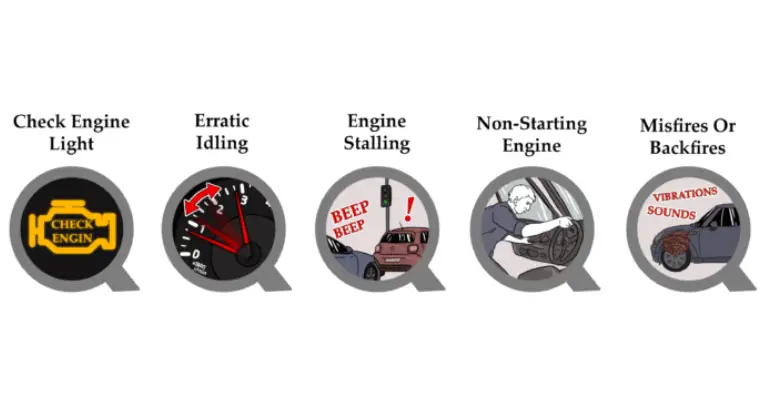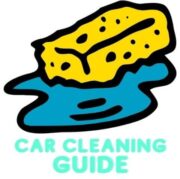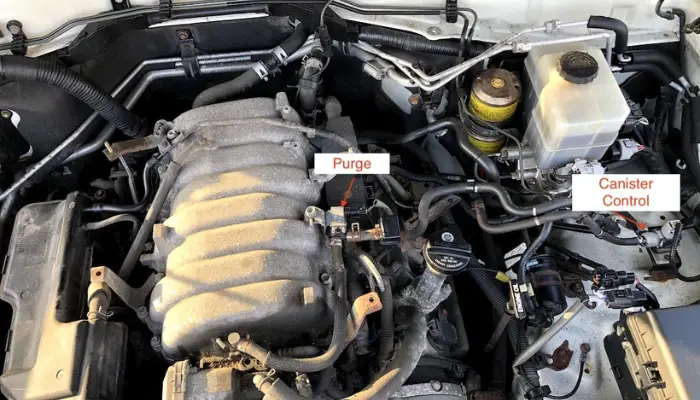Last Updated on August 24, 2023 by Chase Manhattan
Fortunately for us, it’s a relatively simple procedure to bypass purge valves.
In this article, I’ll first show you the procedure to bypass purge valve solenoids – also know as an EVAP purge control valve (PCV), a charcoal canister purge valve, or just a purge valve.
After this procedure, I’ll go into more detail about the overall function of the purge valve as it relates to the evap emission control system and what happens after the bypass solenoid valve procedure. Then, I’ll cover a few specific scenarios like when your purge valve is stuck open or closed, and how you can know when to bypass your purge control valve.
- How to Clean Car Carpets Quick and Easy - July 10, 2024
- Can You Touch Up Clear Coat? Yes and No (Here’s Why) - November 25, 2023
- How To Wax A Car By Hand: A Comprehensive Guide - November 14, 2023
Quick Navigation
How To Bypass Purge Valve In a Few Steps
Here are the steps to bypass purge valve solenoids:
- Locate the engine air intake manifold and the (charcoal) EVAP canister.
- Locate the engine vacuum lines attached to the evap canister. there is typically two engine vacuum lines, one for each of the vacuum ports. These ports can usually be found on top of the canister, and on the bottom.
- Remove the evap purge valve. You may need a socket and a wrench, but sometimes you can get away with just unplugging an electrical connector.
- Plug each vacuum hose to avoid vacuum leaks. Be sure that you don’t miss the second engine vacuum line that is normally found under the EVAP canister.
[How To Clean a Purge Solenoid Valve]
How Does an EVAP Purge Valve Work?
In short, an EVAP purge valve uses vacuum to control and moderate the flow of fuel vapors through the fuel system.
More specifically, engine purge vacuum lines are connected to the intake manifold and the charcoal canister to feed fuel vapors into the intake manifold during the intake strake of the combustion process.
This is how the EVAP system helps reduce harmful emissions, as it uses excess fuel vapors to be combusted instead of being emitted as raw fuel fumes from the exhaust system.
[Why Driving With a Bad Purge Valve Isn’t A Good Idea]
Potential Problems After Bypassing the Purge Valve
While most times, a bypass purge valve procedure is done as a temporary fix but can still create some other issues in the long run.
After bypassing an evap purge valve, you run the risk of developing poor running conditions such as:
- running rich
- hard starting
- misfiring
- check engine lights
- failed emission tests
- excess fuel vapor emissions
- vacuum leak(s)
[Steps to Cleaning an O2 Sensor]
What Causes a Purge Valve To Go Bad?
Like an mechanic component, a purge valve can go bad for numerous reasons – typically outside of our control.
Environmental Exposure
A large determining factor for a bad purge valve is the conditions in which the vehicle lives. In otherwords, if your car is exposed to high temperatures, or freezing temperatures, for consistent periods of time, you may notice premature failure of your evap purge valve.
Low Quality Fuel
If you consistently use low quality fuel, the fuel vapor may emit carbon rich deposits that build up on your evap purge valve and otherwise compromise your charcoal canister.
Time and Degredation
Similar to environmental exposure, and depending on the age of your car, your EVAP purge valve can simply degrade over time leading to an eventual failure.
[Correctly Cleaning a MAF Sensor]

What Are The Symptoms of A Faulty Purge Valve?
All monitored by the ECU/ECM, you will experience a variety of potential issues with a bad purge valve. If experiencing any of these symptoms, you can test the purge valve to confirm it is in fact the component at fault.
Illuminated Check Engine Light
Due to signals from the engine control module, the car’s computer will illuminate the check engine light if you had a bad purge valve.
Failed Emissions Test
Regulations will vary depending on the area, but most times you will fail emission tests from the excess fuel vapor that your car is emitting. Otherwise, you cannot pass emission tests with an illuminated check engine light.
Reduced Fuel Economy
Since your car has disrupted flow of fuel throughout the fuel system, your car will likely run rich will cause your fuel economy to drop drastically.
Difficulty Starting and Rough Idling
Without the proper air fuel ratio, your car will struggle to start – and if it does – it will have difficulty maintaining a consistent idle. Instead, your idle will “hunt” as an industry term, or in other words, you’ll experience a jerky vehicle idle.
Reduced Engine Performance
Similar to the previous point, without a consistent flow of fuel, your car will experience a disrupted air fuel ratio which will lead to sluggishness and misfires when you hit the gas pedal. An engine misfire is created when there is a gap between the engine’s air fuel ratio required for a clean combustion stroke in the cylinder.
Excess Smell of Fuel Vapors
You will also notice the smell of raw fuel when driving as excess fuel vapors build up in the system, or are emitted freely from the EVAP canister.
[Guide for Cleaning Your Catalytic Converter]
What Happens When a Purge Valve is Stuck Open?
When the EVAP purge valve is stuck open, your car will run rich and you will notice excess fuel vapor smells around the car. Fuel vapor return lines are naturally built into the EVAP canister, which means that the fuel cannot be returned to the EVAP canister in the appropriate levels because the flow of fuel vapors will be unregulated.
What Happens When a Purge Valve is Stuck Closed?
When an EVAP purge valve is stuck closed, your car will have difficulty starting and accelerating. This is because the air fuel ratio of the car is drastically disrupted because the unburnt fuel vapor inside the EVAP canister cannot be recycled to the intake manifold as intended.
[How You Can Clean Your Whole Exhaust System]
FAQs and Related Questions
Can You Drive After Bypassing Purge Valve?
Yes, you can drive after bypassing the EVAP purge valve, but you will want to pay extra attention to any fuel smell that may present itself. In extreme circumstances, a clogged vacuum hose or fuel tank vent line may lead to a collapsed fuel tank and further, total, engine emission failure.
What Are The Parts of The EVAP System?
Engine Air Intake Manifold
The intake manifold pulls air, and fuel, into the combustion chamber. This partly determines the air fuel ratio during the combustion process. While gas is fed into the intake manifold from the fuel pump, it also receives recycled fuel from the charcoal canister.
The Fuel Tank
Pretty self explanatory, the fuel tank is essentially the beginning of the EVAP system. It stores the fuel that will later be pulled into the combustion chamber, or excess fuel vapor that is pulled into the charcoal canister for later recycling.
Gas Tank Cap
The gas tank cap is essentially the first “seal” of the evap system. It allows the appropriate levels of vacuum to be generated so that changes in engine vacuum will pull fuel through the fuel pump, down the intake system, and into the combustion chamber.
EVAP Canister
The crux of the EVAP system, the charcoal canister, or EVAP canister, houses and purifies excess fuel vapors that are later recycled during the combustion process.
EVAP Purge Valve
EVAP purge valves operate by allowing excess fuel to be recycled into the engine. It also works to eliminate harmful emissions that will otherwise by distributed into the environment.

